Protective Equipment
Personal Protective Equipment
This section provides an overview of personal protective equipment that should be available and used within a confined space including gloves, foot wear, eye wear and body/skin protection.
Introduction
Entry into confined spaces can pose several hazards and will require the employee to wear personal protective equipment (PPE) to be protected from the hazards. To determine the necessary personal protective equipment, the employees can review:
- Confined Space Hazard Assessment Reports
- The permit lists the PPE each worker needs
CSA Standards Reference Table
Section in the Industrial Establishments Regulation | Applicable CSA Standard | Section Description |
Section 119.12
Personal Protective Equipment | Personal Protective Equipment CSA Z94. 1-05 CSA-794.2-02 CSA Z94.3-02 CSA Zi 95-02 Protective Footwear CSA Z96-02 | The employer shall ensure that each worker who enters a confined space is provided with adequate personal protective equipment in accordance with the relevant plan. |
Section 119.13 Control of Hazardous Energy | Control of Energy
CSA-Z460-05 Control of Hazardous Energy - Lockout and Other Methods | The employer shall, in accordance with the relevant plan, ensure that each worker entering a confined space is adequately protected against the release of hazardous energy into the confined space using the controls outlined in the section. |
Section 119.18(5) Section 119.19(4) | Respiratory Protection
CSA-Z94.4-02 Selection, Use and Care of Respirators CSA-Z180.1-00 Compressed Breathing Air and Systems | Under the circumstances outlined in section 119.18 and 119.19 with respect to atmospheric hazards, the employer shall ensure that a worker entering a confined space uses adequate respiratory protective equipment. |
Section 119.18(5) Section 119.19(4) Rescue Equipment Other Equipment | Fall Protection CSA-Z259.10-M90 (R 2003) Full Body Harnesses (Z259.10 Full Body Harnesses – New edition anticipated in 2006)
CSA-Z259.11-05 Energy Absorbers and Lanyards
CSA-Z259.15 Anchorage Connectors New standard at the technical development stage.
| Under the circumstances outlined in section 119.18 and 119.19 with respect to atmospheric hazards, the employer shall ensure that a worker entering a confined space uses adequate:
¡ Equipment to allow persons outside the confined space to locate and rescue the worker if necessary. ¡ Other equipment as is necessary to ensure the worker’s safety. |
Hand and Finger Protection
There are many types of hazards that can potential injure or damage hands:
- Sharp objects.
- Corrosive chemicals.
- Poisonous chemicals.
- Dirt.
- Rough or abrasive objects.
- Dangerous gases.
- Weather conditions
When selecting the correct type of hand or finger protection, consider the type of hazard you are protecting against. The following are examples of hand protection for specific situations in common workplace scenarios.
Cloth Gloves 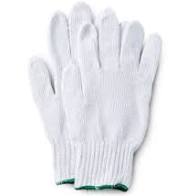
Protect hands against minor physical hazards such as dirt and splinters. Cloth gloves are good for light labour situations.
Leather Gloves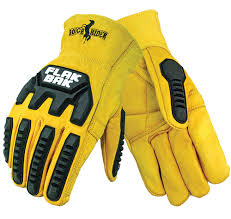
Protect hands against sparks, metal flakes and moderate heat. Used in moderate-to-heavy labour situations.
Rubber/Neoprene/Nitrile Gloves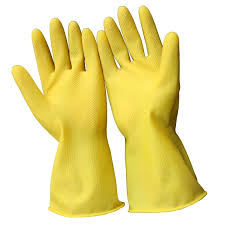
Protect hands from exposure to dangerous chemicals (acids, poisons and gases) and potential electric shock. When selecting these gloves, you must consider the type of chemical that will be guarded against. Some chemicals will have adverse effects on certain materials. Example: Propane will break down rubber gloves and expose the worker to potential frostbite. Neoprene gloves are recommended.
Metal Mesh and Kevlar Glove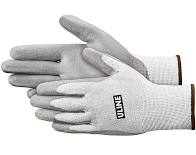
These gloves are used when dealing with rough material or working with sharp tools (knives). These styles of gloves are good for meat cutters and workers who have to handle and clean sharp objects such as blades, tin sniping, metal filings, etc.
Feet and Ankle Protection
Safety shoes are needed in many different situations. Most people hear “safety shoes” and only think about steel-toed shoes. Safety shoes are more detailed than just steel-toed shoes. When selecting safety shoes, you have to consider several variables:
Floor Surfaces
- Dry.
- Wet and greasy.
- Concrete or wood.
Conditions
- Activities.
- Weather conditions.
- Electrical work.
The soles and tread design of shoes should be considered when selecting the correct safety footwear.
- Soft rubber soles are ideal for dry surfaces.
- Hard rubber soles are better suited for wet and greasy concrete and wood flooring.
- Synthetic rubber or compound soles are suited for most surfaces and for ones that change on a daily basis.
- Tread design of safety shoes is also important. Deep treads will filter water away and give better traction on wet floors. Finer treads are designed to give good traction on smooth surfaces.
Other features to consider when selecting the correct safety shoes are the following:
- Steel-toed boots protect from falling or moving objects.
- Steel soles protect against punctures from object such as nails.
- High ankle supports protect against ankle sprain and materials such as sparks from entering the boots.
Remember, in any industry, the shoes and boots that we must wear should be comfortable and give adequate support to help us get through the long workday of standing and walking.
Body and Skin Protection
The body and skin require protection form many different types of hazards and will require many different type of protective clothing and apparatus to do so. When selecting the correct body and skin protection, you should determine the hazards associated with your work activity.
- Exposure to chemicals.
- Sharp objects.
- Welding sparks.
- Heat.
- Weather conditions.
- Impact.
Clothing
Protects the chest, stomach and other body parts from various hazards depending on the material the clothing is designed from. Disposable fabric clothing gives protection from dust and some liquid splashes. Cloth articles are used to protect against metal filings and wood chips. Leather and wool clothing are suited to guard against heat and hot metal. Metal mesh articles give protection from punctures and sharp edges.
Chemical Suits
Give added protection when dealing with hazardous chemicals and biological agents. The suits range from level D suits that give full body protection against dust (coveralls and painter suits) to level C suits, which give splash protection for mild chemical agents and require only air purifier respirator protection, to level B suits, which give added splash protection from more dangerous chemicals that can be absorbed into the skin and require the use of self-contained breathing apparatus (SCBA), to level A suits, which give vapour and splash tight protection and are used with a SCBA in very hazardous situations that could cause skin and respiratory problems. Chemical suits must be selected with the knowledge of the material that you are dealing with, as some fabrics are not suited for some chemicals and will break down the suits and offer no protection.
Consider the following when selecting chemical protective clothing:
- Penetration: The passing of chemicals through a material in opening of pores, stitches and other opening.
- Permeability: The passing of the chemical through the suit at a molecular level.
- Degradation: The wearing down of the suit’s physical properties, resistance to cuts, abrasions or punctures.
Other body and skin protection devices could involve heavy padding to shield the employee from impacts and flame-retardant material to protect from extreme heat.
Respiratory Protection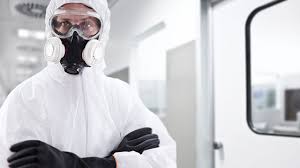
Respiratory protection is used when potential harmful chemicals can enter the respiratory system and cause illness or diseases. To determine the correct type of respiratory protection, the determination of airborne contaminates and concentration is required. There are five types of airborne material:
- Mists.
- Fumes.
- Dusts.
- Vapours.
- Gases.
Selecting the appropriate respirator will come down to two types:
Air Purifiers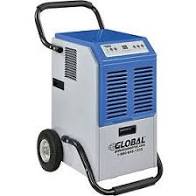
These respiratory protection devices come in various styles and usually come in either half-masks or full masks and use cartridges to filter the surrounding air. These respirators require that enough breathable oxygen is available in the area. The chemicals that you are dealing with must have warning properties (taste or smell) to identify the breakdown of the cartridge, and you must be working in a low concentration of the hazardous chemicals. The selection of the cartridges is very important, as some filters have no affect on different chemicals, so knowledge of the chemical is very necessary to use this mask.
Supplied Air Respirators
These respirators come in two main styles, Self-contained Breathing Apparatus (SCBA) or Life Line Supplied. The SCBA is a unit that is carried with the user and lasts from five minutes up to 60 minutes. A common example is the firefighter SCBA units that are carried on the firefighters’ backs.
The Life Line Style is different as the air is supplied through a breathing hose connected to air bottles or an air cart that forces the air into the breathing mask. This unit can be used for several hours without stopping. The air hose, however, can cause a tripping or snagging hazard. Therefore, careful consideration must be given when selecting a supplied air system.
Escape packs are used in situations when the atmospheric levels are not present or are extremely low, but may have a potential to increase without warning. The escape pack will allow the employee to have an air supply to exit the space if the monitor was to pick up hazardous chemical reading.
When selecting these units, stress on the worker must be considered as using these supplied air units can be physically and mentally demanding. They both have limitations to consider when selecting for certain situations.
Both types of respirators (Air Purifier and Supplied Air) require training in the uses, hazards, limitations, cleaning/inspection and storing, with a proper fit testing to ensure that the employee is wearing the appropriate size and wearing it correctly. Substances such as facial hair and make-up can interfere with the seal, rendering the mask ineffective.
Head Protection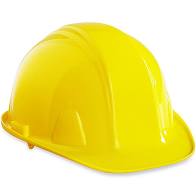
In situations in which a worker is exposed to overhead hazards, head protection is required. Hard hats can protect against the following:
- Falling and flying objects.
- Chemical splashes.
- Molten metal.
- Weather conditions.
- Exposed electrical wiring.
Most hard hats are capable of having other PPE attached to them for added safety:
- Earmuffs.
- Face shield.
- Neck protection.
Bump caps can be used in situations in which some protection is required and should not be used as a replacement for hard hats.
Remember:
- Long hair must be tied back and kept clear from moving machinery and sparks. Hairnets can be used.
- Inspect the hard hat to ensure it is in good shape. Look for dents, cracks and other damage.
- Damaged or painted hard hats must be destroyed.
- Periodically check to make sure the hard hat is adjusted properly. The hat should fit snugly and have an inch separation between the suspension and the shell.
- Do not wear the hard hat backwards; it will not protect you properly.
- Clean often with water and mild detergent, using a soft brush or sponge.
Hearing Protection
Many work environments expose workers to high noise levels on a daily basis. To protect the workers in these situations, hearing protection is used to decrease the exposure of the harmful noise. Injuries due to high noise levels can be very severe and can include hearing loss. There are three basic types of hearing protection:
Earplugs (Disposable and Reusable)
This style of ear protection uses a form plug that the worker rolls between his or her fingers to make it thin. The work then inserts the plug slowly into the ear canal, holding the plug in place while it expands. Disposable plugs must be discarded after use; prolonged use will make them stiff, and they will not sit correctly in the ear canal.
Canal Caps
This type of ear protection is similar to the earplugs; the only difference is that canal caps are on a spring-loaded band and will apply pressure to the earplugs and keep them seated in the ear canal firmly. The canal caps can be inserted and removed quickly.
Earmuffs
They often provide the best protection for the ears, as earmuffs use foam or liquid to block the sound and cover the entire ear. These muffs are good for dusty and dirty environments and are good for long- or short-term protection. Another advantage of this hearing protection is that earmuffs can be used in conjunction with earplugs to give more protection.
Eye Protection
In many workplaces, eye protection is required to prevent the employees from being exposed to eye hazards. Our eyes are very complex and fragile organisms and can be damaged easily. Selecting the correct eye protection will depend on the work environment and work process involved. The following activities may require eye protection:
- Grinding, flying debris, etc.
- Working in sunny conditions.
- Welding.
- Using chemicals
- Standard Safety Glasses
Used in most situations. Most models have shatter-resistant lenses with side shields that will protect you from flying debris. These glasses are now being produced in more “fashionable” styles and are lighter in weight than the traditional glasses. Tints can be added to give eye protection from the sun, glare, welding glow, etc. Not all tints are made for all types of jobs; selecting the proper tint will depend on the job at hand and the intensity of the light being shielded.
Some situations require snug-fitting goggles to give protection from all angles. Goggles are mostly used when dealing with chemicals to protect against splashes. Vent holes are used on the goggles to allow airflow and to help them from fogging up during use.
Additional face protection may be necessary; therefore, face shields or welder’s helmets are available to give protection. Safety glasses and goggles should be worn under the face shields for complete protection. The face shield does not replace the need for safety glasses; the face shield just gives added support.
Keep the glasses, goggles and shields in good condition as poorly maintained equipment can lead to eyestrain and fatigue. Do not use an abrasive cleaner or cloth to clean your eye protection.
Caution: Contact lenses may not be worn when dealing with some chemicals as they may be affected and damage the worker’s eyes even further. Check with your supervisor or refer to the Material Safety Data Sheet for more direction.